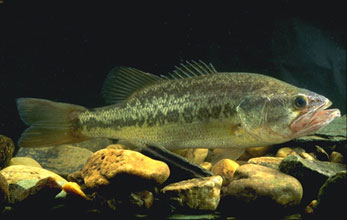Largemouth bass
The largemouth bass is a freshwater game fish in the sunfish family, a species of black bass native to North America. It is also known by a variety of regional names, such as the brown bass, widemouth bass, bigmouth bass, black bass, bucketmouth, Potter's fish, Florida bass, Florida largemouth, green bass, green trout, gilsdorf bass, linesides, Oswego bass, southern largemouth and northern largemouth. But, it is not a member of the bass family but actually a member of the Sunfish family.[1] The largemouth bass is the state fish of Alabama (official freshwater fish),[2] Georgia,[3] Mississippi,[4] Florida[5] (state freshwater fish), and Tennessee[6] (official sport fish).
Physical description
The largemouth is an olive green fish, marked by a series of dark, sometimes black, blotches forming a jagged horizontal stripe along each side. The upper jaw (maxilla) of a largemouth bass extends beyond the rear margin of the eye.[7] In comparison to age, a female bass is larger than a male.[8] The largemouth is the largest of the black basses. The largest reached a maximum recorded overall length of 29.5 in (75 cm)[9] and a maximum unofficial weight of 25 pounds 1 ounce (11.4 kg).[9] The fish lives 16 years on average.[10]
Forage
The juvenile largemouth bass eats mostly small bait fish, scuds, small shrimp, and insects. At about a year of age they become cannibalistic, eating other largemouths their size or smaller.[11] As they mature they no longer consume their own kind.[11] Adults consume smaller fish such as gizzard shad, fathead minnows and bluegills. These are swallowed head first.[11] crustaceans such as crayfish are swallowed tail first.[11] Largemouths can consume other fish up to 50% of their own length. sunfish and crustacean they eat tend to be no more than 35% of their own length.[11] They will eat almost anything they can find in the water—snakes, mice, young waterfowl, birds and shrimp.[12]
In larger lakes and reservoirs, adult bass occupy deeper water than younger fish. They shift to a diet consisting almost entirely of smaller fish like shad, yellow perch, ciscoes, shiners, and sunfish. Largemouth also consume younger members of larger fish species, such as pike, catfish, trout, walleye, white bass, and striped bass. The largemouth bass uses its senses of hearing, sight, vibration, and smell to attack and seize its prey. Adult largemouth are generally apex predators within their habitat, but they are preyed upon by many animals while young.[13]
Angling
Largemouth bass are widely sought after by anglers and are noted for the excitement of their fight. The fish will often jump out of the water in their effort to throw the Fishing hook. Anglers most often fish for largemouth bass with lures such as plastic worms (and other plastic baits), jigs, crankbaits and spinnerbaits. A recent trend is the use of large swimbaits to target trophy bass. Live bait, such as nightcrawlers, minnows, frogs, or crawfish can also be productive. Many bass anglers practice catch and release, especially the larger specimens. This is because larger specimens are usually breeding females that contribute heavily to future sport fishing stocks. Largemouth bass, if handled with care, respond well to catch and release.
The world all-tackle record largemouth bass was caught by George Perry in Montgomery Lake in Georgia in 1932. It weighed 22 pounds and 4 ounces.[14] In 2009 a 22-pound, 4.97 ounce largemouth was caught in Japan by Manabu Kurita.[14] By International Game Fish Association (IFGA) rules, a record fish of under 25 pounds must beat the previous record by 2 ounces or more to be a new record. The IFGA considers the two fish to share the current world record.[15] However, the largemouth caught by George Perry in 1932 still holds the Georgia state record.[16]
Largemouth Bass Media
References
| Wikimedia Commons has media related to Lua error in Module:Commons_link at line 62: attempt to index field 'wikibase' (a nil value).. |
- ↑ "Black Bass". Florida Fish and Wildlife Conservation Commission: Division of Freshwater Fisheries. Archived from the original on April 23, 2006. Retrieved March 17, 2007.
- ↑ "Alabama State Freshwater Fish". State Symbols USA. n.d. Archived from the original on 1 April 2014. Retrieved 13 May 2014.
- ↑ "Georgia State Symbols". State of Georgia. Archived from the original on May 1, 2008. Retrieved May 9, 2008.
- ↑ "State Symbols". State of Mississippi. Archived from the original on October 10, 2007. Retrieved May 9, 2008.
- ↑ "State Freshwater Fish". State of Florida. Archived from the original on August 27, 2013. Retrieved May 9, 2008.
- ↑ "State Symbols". State of Tennessee. Archived from the original on October 11, 2007. Retrieved May 9, 2008.
- ↑ "In-Fisherman Largemouth Bass Description". Archived from the original on 2011-01-02. Retrieved 2014-05-13.
- ↑ Robert Wallus; Thomas P. Simon, Reproductive Biology and Early Life History of Fishes in the Ohio River Drainage, Volume 6 (Boca Raton, FL, CRC press, 2008), p. 341
- ↑ 9.0 9.1 "Escondido's world-famous bass found dead". San Diego Union-Tribune. Archived from the original on August 27, 2013. Retrieved May 27, 2009.
- ↑ "Largemouth Bass (Micropterus salmoides)". Texas Parks and Wildlife. Retrieved October 3, 2008.
- ↑ 11.0 11.1 11.2 11.3 11.4 Robert Wallus; Thomas P. Simon, Reproductive Biology and Early Life History of Fishes in the Ohio River Drainage, Volume 6 (Boca Raton, FL, CRC press, 2008), p. 347
- ↑ John Weiss, The Bass Angler's Almanac: More Than 650 Tips and Tactics (Guilford, CT: Lyons Press, 2001), p. 7
- ↑ "In-Fisherman – Largemouth Bass Forage". Archived from the original on 2011-04-10. Retrieved 2014-05-13.
- ↑ 14.0 14.1 Ken Duke (June 2, 2013). "George Perry's world record bass; Eighty-one years and counting atop the bass fishing mountain". Bassmaster. Retrieved 13 May 2014.
- ↑ "IFGA Online Record Search". INTERNATIONAL GAME FISH ASSOCIATION. 2014. Retrieved 13 May 2014.
- ↑ "Georgia State Record Freshwater Fishes; Bass, Largemouth". Georgia Department of Natural Resources. 2014. Retrieved 13 May 2014.[dead link]


